Categories
Links
Archives
Tag Cloud
Volunteer in Bolivia at a children’s center (Interview part I)
Author: adminViews 13.525 17 dic
How could you learn Spanish in South America while discovering places and cultures and also doing something useful? It’s a question many of our volunteers initially have asked themselves before they started to plan their trip.
Working as a volunteer in Bolivia is for many the perfect answer. Volunteer Work Latin America arranges placements at an integrated child care center in a beautiful semi-rural valley surrounded by the red and green Andean mountains at only 15 km. from La Paz, capital of Bolivia.
The center, or “the Nursery” as Emma (one of the humble founders of the project) affectionately calls it, has caused a tremendous impact on the largely indigenous population, pulling them out of very vulnerable situations and social, economic and political exclusion. We have asked her a few questions about the project and the involvement of volunteers.
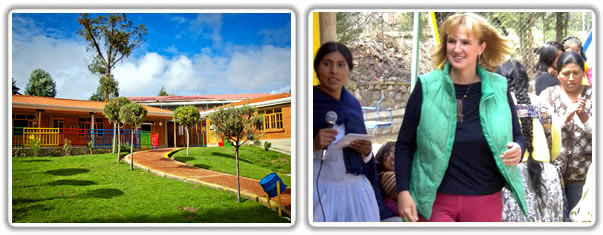
Can you explain your role in the organization?
The children’s Centre started in my home with 30 children. We now have a lovely purpose built children center with just under 90 children, between the ages of 6 months and 4 years that come to learn, to play and to be nurtured. Whilst I was very involved in the first two years raising and managing the project, the Centre is now run entirely by local women, many of them indigenous Aymara who wear the traditional bowler hats and wide skirts. My role is now mainly concerned with fundraising to ensure the sustainability of the project and coordinating the work of the volunteers to provide vital hands-on support in the classrooms and for the care of the children.
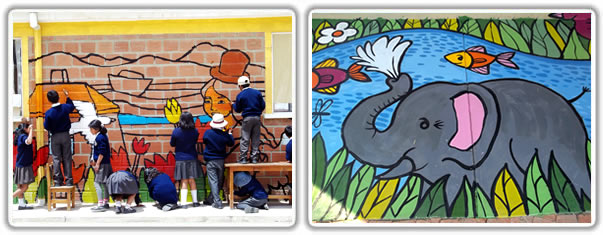
What was the inspiration behind this project?
The village had no child care facilities and many women had no alternative but to literally lock their children in the house, or leave them in the care of other young siblings in order to go out to work. This led to children being very exposed to accidents, abuse, hunger and malnutrition. For example one child was badly burnt as his 7 year old brother tried to heat water for lunch. When we started, over 70% of the children were undernourished too as their parents lacked the time, money and knowledge to provide them with regular nutritious meals.
How is the project run at present?
The Centre was designed and built by the local Mothers Club, and we hope to continue supporting the professional development of the 10 locally trained women called ‘tias’ who operate the Centre as well keep improving our attention to the children. The children’s Centre, located in green parkland at the heart of the community, is now a reference for community-led child empowerment with a focus on promoting the rights and culture of the local children. Together as a community we created a place that is inclusive, encouraging the poorest families to use our services also for children with special needs that no one else is willing to accept. That said the Centre is not to be simply a place where the families drop their children off and pick them up later in the day, but rather a place where they can also learn about nutrition, early education, rights and receive vocational training.
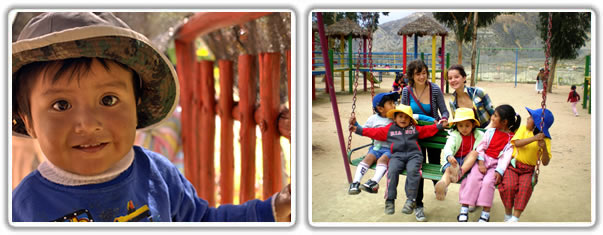
Could you give us some examples of the tasks assigned to volunteers?
Volunteers bring creativity and new ideas which inspire the local educators and their families. Volunteers in the past have done dance classes, music classes with homemade instruments and played games on the beautiful grounds of the Centre. Recently we have been donated baby-gym equipment which the children love, but this needs to be done with small groups which often are outside the scope of the teachers. With the older children the volunteers prepare activities which reinforce the learning goals each week in maths, language and social skills development. Volunteers also participate in the feeding and medical care programs, cultural activities and festivities, which happen with amazing frequency, often being pulled into traditional dance shows or to prepare the children to sing or perform in front of their parents and the wider community.
To continue reading more about the involvement of volunteers in this social project in Bolivia, click here for the rest of the interview.

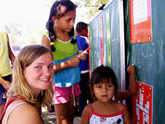
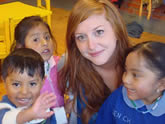
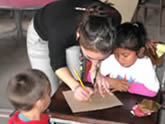
5 Responses for "Volunteer in Bolivia at a children’s center (Interview part I)"
Seems like a great project! If one day I head for Bolivia….
Does de project need volunteers in March? I might be heading to Bolivia in March and would love to help.
This school looks amazing…with so much space for the children as well. I would like to learn more..first of all what are the accomodation options for volunteers? gracias
Hello Maggy. We will organise home-stays with local families, in a private or twin room with access to a bathroom and kitchen so that volunteers can cook for themselves – or it may be possible to share family meals. Alternatively you can choose to be more independent and stay in an all-volunteer house known as ‘The Green House’ in the local community with modern decor and light airy rooms, but best of all is the view from the balcony which look out to the Andean mountains, the ominous “Devil’s Tooth”, valley and river below. For more information please contact us at info4@volunteerworklatinamerica.org
Volunteers can work full time of part time. The nursery runs from 8am to 5pm Monday to Friday. A Basic level of Spanish is required – or you can buddy-up with another volunteer to help you communicate with the project staff and children. Nobody speaks English, so it is a perfect place to learn Spanish!!! For volunteers working a full day, snacks and lunch will be provided free.
Leave a reply